THE “IMPOSING” VIEW FROM OCEAN HILL (1848)
******************************************************************************************************************************** Brownstone Detectives investigates the history of our clients’ homes. The story you are about to read was composed from research conducted in the course of one of those investigations. Do you know the history of YOUR house? ******************************************************************************************************************************** Before there was Ocean Hill—the Bedford-Stuyvesant neighborhood—there was Ocean Hill—the section of Green-Wood Cemetery. Whether one influenced the other is lost to the ages. What is clear, however, is that both locations got their names from a geographical point from which a body of water could clearly be viewed. “At this point, now known as Ocean Hill,” described a contributor (whose pen-name, revealingly, was Investment) in an edition of the Brooklyn Daily Eagle published just a few years before the Civil War began, “we have reached the highest point on the avenue (Fulton Street) and the most commanding elevation of ground in the city; and which, for grandeur, beauty and variety of its scenery, cannot be surpassed. “The ocean view,” Investment continued, “is especially grand and imposing.” Investment, whose contribution to the paper existed as a thinly veiled promotional piece for Brooklyn, was describing the “advance in the value of Brooklyn real estate.” From Fulton Ferry he advanced down Fulton Avenue to “gather such information as will enable the public to form an intelligent estimate as to the present and prospective value of property on and near this great thoroughfare.” “At this point Fulton avenue is distant but a few hundred feet from Atlantic avenue on the south, and Broadway on […]
BOERUM HILL TIMEWARP! (1922 vs. 2018)
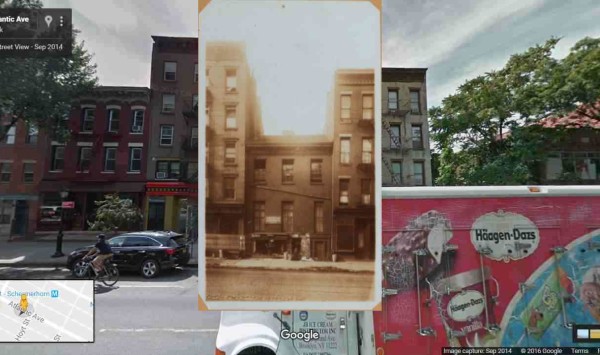
******************************************************************************************************************************** Brownstone Detectives investigates the history of our clients’ homes. The story you are about to read was composed from research conducted in the course of one of those investigations. Do you know the history of YOUR house? ******************************************************************************************************************************** It’s always a blast to compare old photographs of Brooklyn streets with what is there now. Often the old buildings, street lamps, and flagstone sidewalks are long gone, but sometimes you are discover a treat that makes the journey worthwhile. With a little help from the internet it’s easy to make these comparisons and then to even bring the past back to life. Using the Old NYC app, which allows you to search a map of the city to find locations where old New York City pictures were taken (and are stored at the New York Public Library’s Digital Collections), you can search for any address within the five boroughs. With some luck you might find an actual picture of the building or location you are looking for. With our case, we were looking for street addresses on Atlantic Avenue. Searching the database, we found 336 Atlantic Avenue. The picture was described as “336 Atlantic Ave., south side, west of Hoyt Street,” and this particular photograph had a little more information than you usually get on this site – information on the building’s conveyance from one owner to the next, likely around 1922. The caption at the library’s site further notes that the photograph showed “a home bought by Mrs. Pruize […]
B’KLYN GALS SEEK LEAP YEAR COWBOYS (1912)
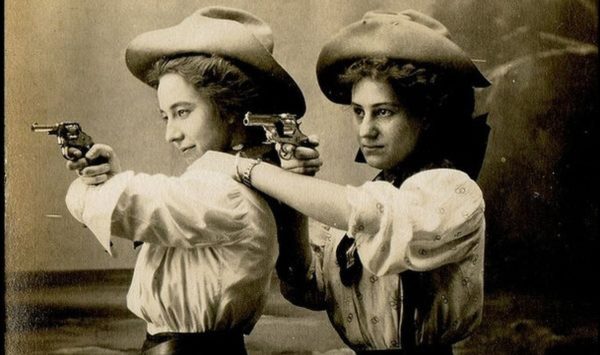
******************************************************************************************************************************** Brownstone Detectives investigates the history of our clients’ homes. The story you are about to read was composed from research conducted in the course of one of those investigations. Do you know the history of YOUR house? ******************************************************************************************************************************** “Come on boys; don your riding chaps, brush up your sombrero and dig out your rusty six-shooter and look-like a moving picture hero!” So started the article in the Sacramento Bee in April of 1912 about two Brooklyn sisters who were looking far afield for long-distance leap year affairs. Alma and Lou Bahn of 546 Washington Avenue, a boarding house between Fulton Street and Atlantic Avenue known as The Berwick, were taking this leap year business seriously, it seemed, and the men of the borough of Brooklyn, it seemed, could not hold down the sisters’ adventuresome spirits. “They want to correspond with you and perhaps the corresponding may lead to love and to the altar,” continued the Bee story. “The girls apparently realize that California is overrun with cowboys and that some of them are so dare devil and roguish that they buy their chewing gum in cigar stores,” continued the Bee. “Therefore, they ask for the names of several in order that they can each pick out a ‘nice’ cowboy and not a Black Bart the second or a California Jesse James. “The Brooklyn belles do not give their ages, but their pictures indicate that they are, or were, young. That they are not idle flirts seeking to catch some […]
ATLANTIC TERMINAL – 1910 vs. 2018
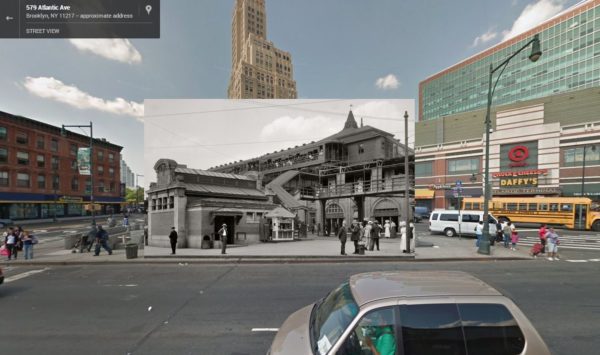
******************************************************************************************************************************** Brownstone Detectives investigates the history of our clients’ homes. The story you are about to read was composed from research conducted in the course of one of those investigations. Do you know the history of YOUR house? ******************************************************************************************************************************** We found a photograph taken at the “Atlantic Avenue subway entrance,” circa. 1910, and superimposed it onto an image taken from the same location, circa. today (courtesy Google Maps). The old picture shows an elevated railway and streetcar tracks in the background – the elevated railway is now underground and the streetcar has been replaced by city busses. If you look closely at the train cars, you can see that they are open on the sides, showing the time of year the photograph was taken. Also telling of the period (and the time of the year) are the boaters that the men are wearing – they were en vogue in mean’s spring/summer fashion at the time. There are also a couple of policemen, looking very much like London “bobbies” or “Keystone Cops” with their distinctive helmets. Notice anything else? Follow @BrownstoneDetec Share ———————————————————————————————————————– The Brownstone Detectives Brownstone Detectives is an historic property research agency. Our mission is to document and save the histories of our clients’ homes. From our research, we produce our celebrated House History Books and House History Reports. Contact us today to begin discovering the history of your home.
THE BOY WHO COULDN’T MEND (1914)
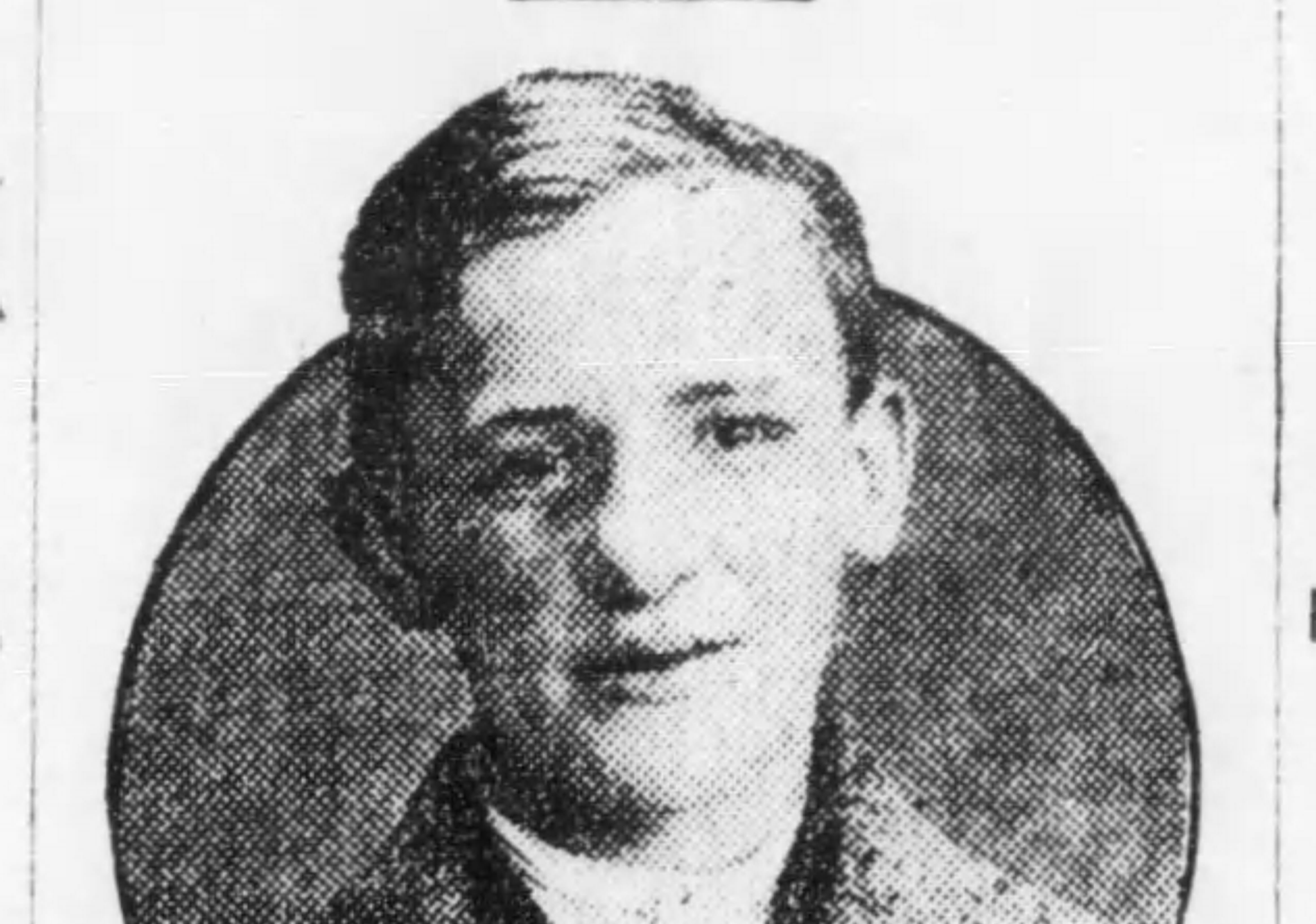
Some criminals just cannot reform. Young Raymond “Angel Face” Beck was a good example. 100 years ago today, the 14-year-old Brooklyn boy was pawning stolen silverware on Atlantic Avenue when the police happened into the pawn shop. NO JUVENILE ASYLUM BUILT COULD HOLD THE “ROBBER CHIEF” Known mostly for his escapes from “prison,” at the time, Raymond Beck, “son of well-to-do parents of 7 Cypress Avenue,” and a self-described “Robber Chief,” had broken out of the Dobbs Ferry Juvenile Asylum a total of four times by 1914. Each time young Beck, “blue-eyed, fair-haired and innocent-looking,” made a B-line directly for Brooklyn and the houses of new victims. Beck would make a career of illegal activity and escaping asylums and reform schools throughout his life. The newspapers are replete with his stories of burglaries and escapes at least through the mid-1920s, when he would finally disappear from the news. But, for the majority of this period, whenever the name Raymond Beck was mentioned in the papers, Brooklynites locked their doors and hid their valuables, as there was a good chance they’d end up in his possession. “ANGEL FACE” RETURNS TO BROOKYLN After the “boy burglar” had most recently been paroled in 1914, he ended up in Brooklyn once again – this time in the parlor of Edward A. Peterson of 567 Eighth Street in Park Slope. Now, Peterson did not know “Angel Face,” but that was not only because the two had never been introduced. Beck simply arrived at Peterson’s home […]
BROOKLYN’S “GREAT WHITE HURRICANE” (1888)
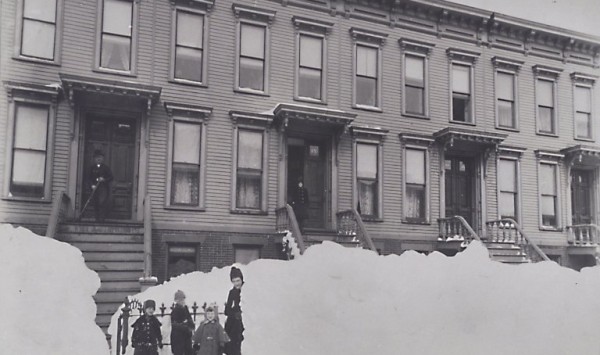
“Brooklyn awoke this morning to find itself in the hands of the blizzard.” So read the morning edition of the Brooklyn Daily Eagle almost 130 years ago on Monday, 12 March 1888, about the record snowstorm that, over a day-and-a-half period, dropped up to three feet of snow on the city, produced sustained winds of 40 miles per hours, and created snowdrifts in some places in excess of 50 feet! Nearly all transportation was shut down completely and many Brooklynites were confined to their homes for up to a week. While the city slept the rain that had rendered last evening slightly unpleasant had turned to snow, the wind had increased to a tempest and all life was driven from the streets. Street cars were unable to proceed. The horses were detached and taken to the nearest place of shelter. The inmates of the cars saw the huge drifts of snow pile up above the window ledges, heard the shrieks of the wires above their heads and did not leave the cars unless an open house was very near at hand. It was about 1 o’clock when the storm became furious and it raged for ten hours with undiminished violence. Those who ventured out during the morning were treated to a view of the city unparalleled in its history. During the entire morning there was little concerted effort, except along the principle business part of Fulton Street, to open traffic or carry on any business. Half the city felt that […]
A COLLAPSE, A DEATH, & AN INQUIRY (1912)
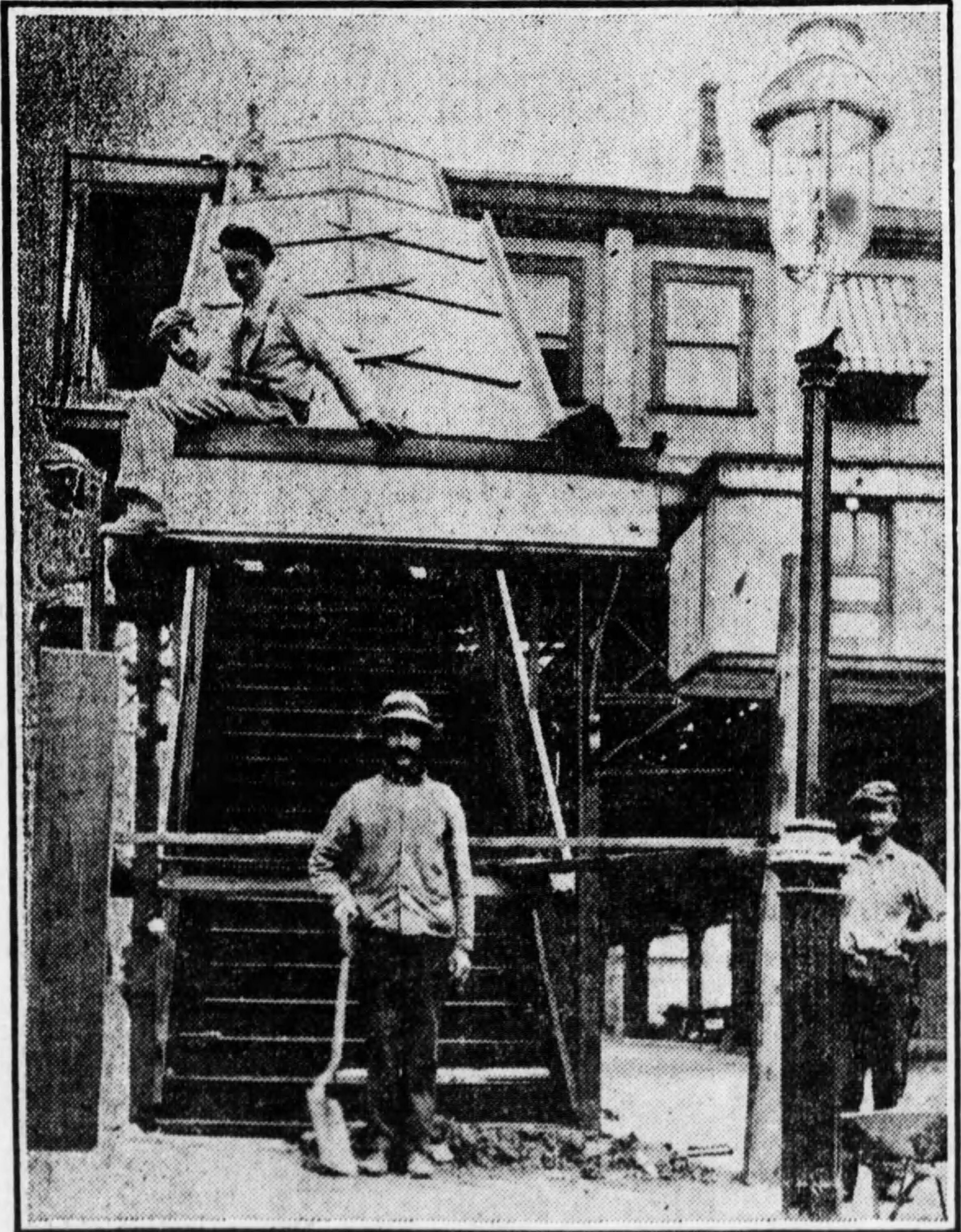
******************************************************************************************************************************** Brownstone Detectives investigates the history of our clients’ homes. The story you are about to read was composed from research conducted in the course of one of those investigations. Do you know the history of YOUR house? ******************************************************************************************************************************** It happened just before Christmas of 1912. A young husband in the prime of his life rushes to buy a last-minute Christmas gift for his beautiful wife. With the pearl necklace safely deposited in his suit-coat pocket, he dashes to catch the train that is approaching. Rushing up the stairwell to the Long Island Rail Road (L.I.R.R.) platform, he quickly reaches the top step. As he turns the corner to run for the platform, he barely senses the very stairwell beneath him shifting almost imperceptibly beneath his feet. Then, as a loud crack reports his entire balance has shifted, and he is suddenly in a terrifying free-fall. Seconds later the young husband’s body is covered with tons of – what had seconds before been – concrete stairs. This fatal collapse of the L.I.R.R. stairwell occurred at Atlantic and New York avenues, and was subsequently blamed on the corrosion of two cast-iron posts which supported the entire concrete structure. The tragedy on the L.I.R.R. stairway at New York and Atlantic avenues ended in the sudden death of a well-known art expert, David H. Cochran of 113 Macon Street. THE BEGINNING OF A “BIG” INQUIRY The very day afterward, as the finger-pointing already began to take place, a “big” inquiry was established which […]
DID BROOKLYN GIRLS SMOKE? (1887)
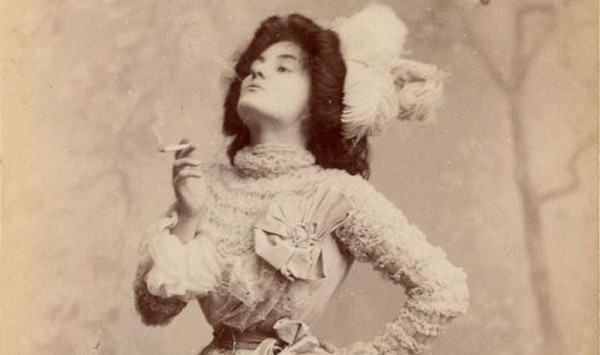
******************************************************************************************************************************** Brownstone Detectives investigates the history of our clients’ homes. The story you are about to read was composed from research conducted in the course of one of those investigations. Do you know the history of YOUR house? ******************************************************************************************************************************** “There are more women in the City of Brooklyn who smoke cigarettes than any one…would ever dream of.” So floated the words of a Fulton street cigar store proprietor one evening in 1887, after a boy “of 12 or 13 years of age” entered and asked him for “a package of the same kind she got last night.” I was paid to find out why. So, going to the source, I found a few men who talked. Actually, they sang like canaries. And I kept good notes. TRACKING A RUMOR TO ITS SOURCE The cigar store I walked into was doing a brisk business. But the customers were men. All men and, from time to time, a few boys. Playing the bored customer, I perused the tobacco boxes, fiddled with the cigar cutters, and then spotting the proprietor – rather he spotted me! – he struck up a conversation. Like most customers who either didn’t know what they were looking for or had ulterior motives, I told him that I was just browsing. Taking him into my confidence just then, I asked him where all of his female customers were. Arching an eyebrow, he shot me a knowing glance, patted the side of his nose, and waved a hand before me, […]
“GROUND TO PIECES” IN THE CUT (1914)
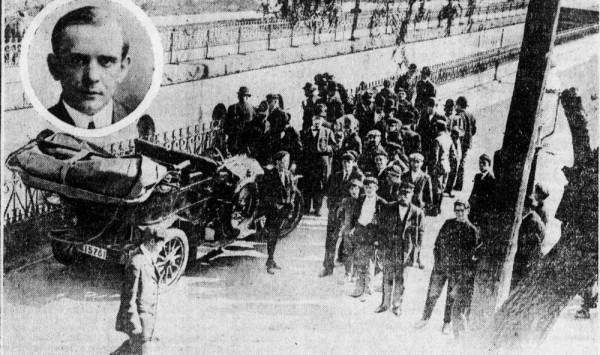
Martin Conly was the first to die by the cut in 1908. He and a boyhood “chum” were back from Coney Island at about 1 a.m. when the automobile they were traveling in ran into the low iron guard rail. Conly, the son of a prominent Brooklyn Democratic ward leader, was thrown from the vehicle and onto the tracks below. He was killed instantly. The Long Island Rail Road, which was not held accountable in court for the death, would later remove the light iron fencing and replace it with a thick concrete wall to prevent the same thing from happening again. Just a month later, though, before they could eradicate the danger – it happened again. Five young men, enjoying a “joyride” in a “large touring car,” heading north on Howard Avenue toward Atlantic Avenue, plunged into the wide trench and landed on the tracks “25 feet below,” just as a train was scheduled to pass. It was 2:10 a.m. It wasn’t until 27 December 1914, though, that an automobile would plummet into the cut while a passing train “ground to pieces” a man and his automobile. It had been traveling south on Howard Avenue towards Atlantic Avenue, when it crashed into the iron fencing. Unfortunately, the Long Island Rail Road had not found it necessary to build the same type “re-enforced” concrete wall on the north side of the cut (as it had on the south). MITIGATING THE CUT Today, the mitigation is noticeable – but just barely. […]
SURVIVING THE ATLANTIC AVENUE “CUT” (1920)
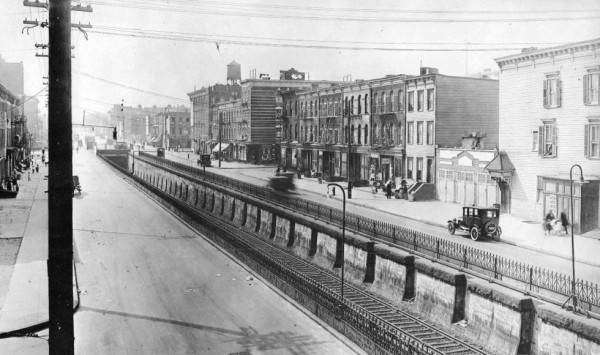
O! What a difference 90 years makes. The Long Island Rail Road (L.I.R.R.) “Cut,” which divided the eastward and westward sides of Atlantic Avenue, was a much more scenic feature back in the day. In this photograph taken looking eastward from Howard Avenue, a small family walks with a baby carriage at the lower right, and a woman, above them, looks out of the window. Shoppers along with residents of the houses fill the sidewalks, as they run errands, talk with one another, and take in the streets scenes, themselves. These scenes were representative of the entire stretch of the avenue of the time. As the automobile came into prominence, though, and repair shops and filling stations began congregating along the avenue, the people began to disappear, along with their residential buildings, the latter of which were really not that old at the time. Sadly, none of these buildings appear to be standing today. Notice the number of ornate Victorian-era wood-frame houses that were in existence then. Also, notice the cast-iron fencing that the L.I.R.R. used to keep pedestrians from falling – and drivers from plunging – down into the “cut.” Unfortunately, for a number of motorists driving in the direction of the tracks, this fencing was of little help. With the low height of the old cast iron fence that lined the “cut,” many night-time drivers had a difficult time realizing – as they perpendicularly approached the “cut” in the dark – that there was actually no path between […]